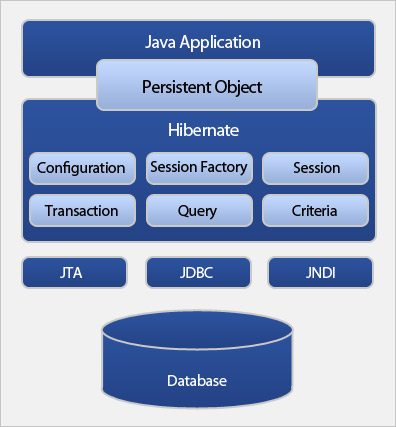Introduction To Hibernate 4.0
Hibernate is a Object-relational mapping (ORM) tool for Java. It was initiated by Gavin King in 2001. ORM methodology is used to map classes to tables, class instances is mapped to rows and attributes are mapped to table columns. It also map data types of Java to SQL data types.
Hibernate is a persistence framework which used to store and fetch data from Java environment to database table. Persistence is a storing process of data to permanent storing medium like SQL database and fetching back to any time which may be after ending the process which stores data to this table.
Here is the video tutorial of: "Introducing the Hibernate 4 framework to beginners"
Advantages of using Hibernate
- It handles the mapping of Java class to the database table using
annotation or XML file. You don't need to write any code to map it.
- Java objects can be store directly and fetch from the database using
it's easy APIs.
- Later on , if there is a change in any table or Database, you need
to change only the XML file and the Java Class related to the table.
- You don't need to take care of SQL data type, you just need to work on
familiar Java data types.
- It doesn't need any application server to function.
- Reduce database access complexity by easy fetching techniques.
- It has easy and simple query for data access.
Supported Database
Hibernate supports following RDBMS :
- MySQL
- Oracle
- PostgreSQL
- FrontBase
- DB2/NT
- Microsoft SQL Server Database
- Sybase SQL Server
- Informix Dynamic Server
- HSQL Database Engine
Hibernate Architecture
The figure given below represents the architecture of Hibernate :

Hibernate Configuration
The configuration of Hibernate is handled by the instance of org.hibernate.cfg.Configuration . It symbolizes the complete mapping between Java data types to the SQL database or database table. It is used to construct org.hibernate.SessionFactory . Various XML mapping files or Java Annotations compilation build these mapping.
Following 3 types of configuration is provided by the Hibernate :
(1) hibernate.cfg.xml
This XML file resides in root of application's CLASSPATH. This file constitutes hibernate configuration.
A sample hibernate.cfg.xml file is given below :
<?xml version='1.0' encoding='utf-8'?> <!DOCTYPE hibernate-configuration PUBLIC "-//Hibernate/Hibernate Configuration DTD//EN" "http://hibernate.sourceforge.net/hibernate-configuration-3.0.dtd"> <hibernate-configuration> <session-factory> <property name="hibernate.connection.driver_class">com.mysql.jdbc.Driver</property> <property name="hibernate.connection.url">jdbc:mysql://192.168.10.13:3306/ankdb</property> <property name="hibernate.connection.username">root</property> <property name="hibernate.connection.password">root</property> <property name="hibernate.connection.pool_size">10</property> <property name="show_sql">true</property> <property name="dialect">org.hibernate.dialect.MySQLDialect</property> <property name="hibernate.current_session_context_class">thread</property> <mapping class="worker.Worker" /> </session-factory> </hibernate-configuration>
(2) hibernate.properties
This property file contains the key-value pair for different hibernate configuration.
The sample hibernate.properties file is given below :
hibernate.connection.driver_class=com.mysql.jdbc.Driver hibernate.connection.url= jdbc:mysql://192.168.10.13:3306/ankdb hibernate.connection.username=root hibernate.connection.password=root hibernate.connection.pool_size=1 hibernate.transaction.factory_class = \ org.hibernate.transaction.JTATransactionFactory hibernate.transaction.manager_lookup_class = \ org.hibernate.transaction.JBossTransactionManagerLookup hibernate.dialect = org.hibernate.dialect.MySQLDialect
(3) Programmatic configuration
This is the manual configuration which needs to be done in Java file. We can get an instance of org.hibernate.cfg.Configuration directly by specifying mapped class using .addClass( ).
Configuration cfg = new Configuration() .addClass(worker.Worker.class) .addClass(worker.Department.class);
Building a SessionFactory
After creating instance of org.hibernate.cfg.Configuration , you can create instance of SessionFactory as follows:
SessionFactory sessions = cfg.buildSessionFactory();
Creating Session instance
Between database table and application, Session represents a communication channel. From SessionFactory , Session can be created as follows:
Session session = sessions.openSession();
